

The game's enduring popularity comes from its vibrant collection of original designs based on the series' vulgar-yet-lovable sextuplets, supported by new stories, scores of original music, and recurring settings. Although the base gameplay is simple— if at all existent— Hesowars captured a loyal audience for its years of near-weekly updates.
This timeline is meant to capture trends and interesting moments in the game's development from its launch in February 2016 to its conclusion in October 2022.
Click an item to show its description.


While much of the terminology in Hesowars was basically English loanwords, many names never recieved an official romanization, so please take the amateur translations on this page with a grain of salt.

Hesowars first launched on Android on 9 February 2016.
iOS launched a month later, on 4 March 2016.
If you see either of these dates on a player's NEET Resume, it means they've been in since the beginning!

About half a month after its 'complete' release, Hesokuri Wars reported one million downloads!
By the summer, the game had reached two million downloads.
As an English-language comparison, this is about equivalent to the download numbers for the cult favourite visual novel Doki Doki Literature Club.
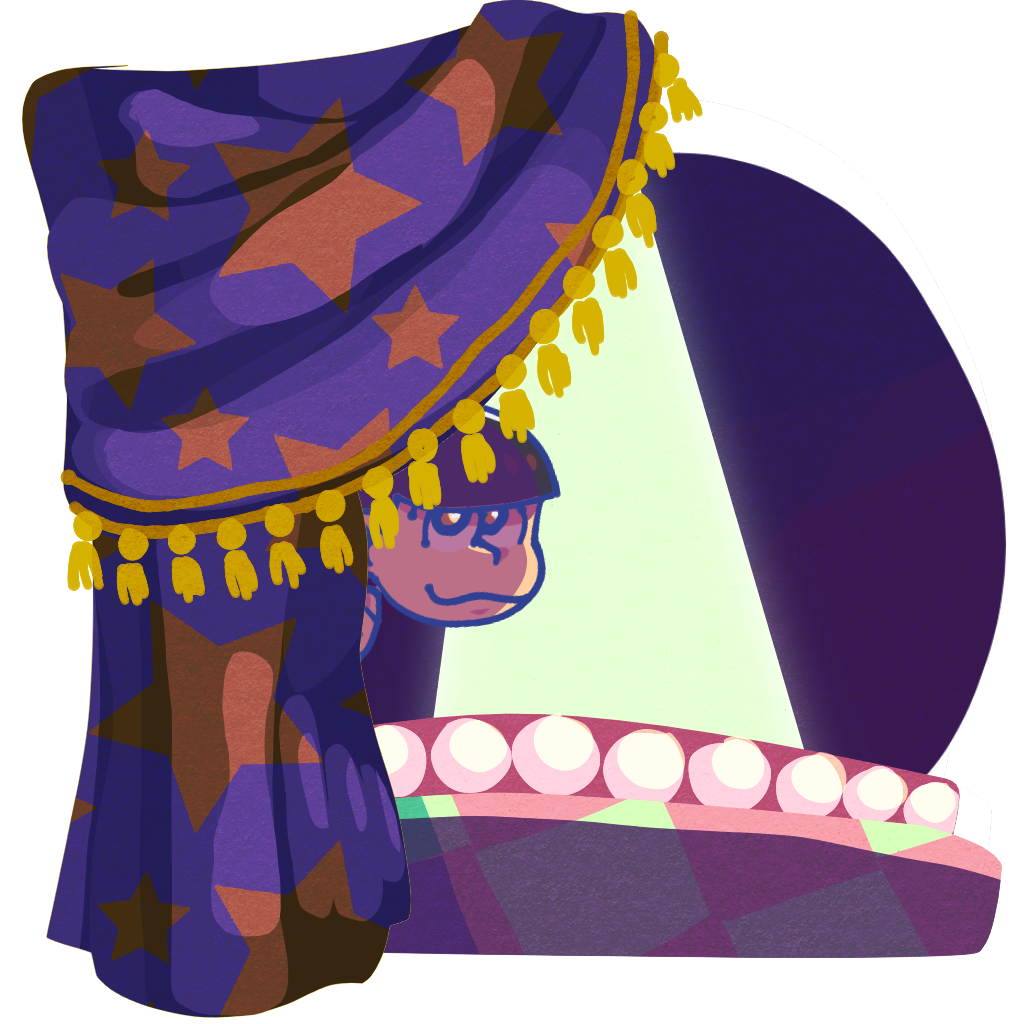
As soon as Hesokuri Wars was fully launched, it began to run special series of limited-time stages known as 'events'.
The first event was [White Day], and introduced the event gacha system. Completing the ten event stages granted unique currency points that could be used to draw for themed 3★ characters in a time-limited gacha.
The first story event, [Springtime Normie BAN! Festival] came two weeks later. In addition to more new 3★ characters, the event told a brief story between stages through the same dialogue pop-ups as the in-game tutorial.
The next event, [Matsuno Quest], was the first unique, designed-and-written-just-for-Hesokuri-Wars story event. Its approach to genre parody -detail oriented if not a little cynical- set the standard for all future story events.
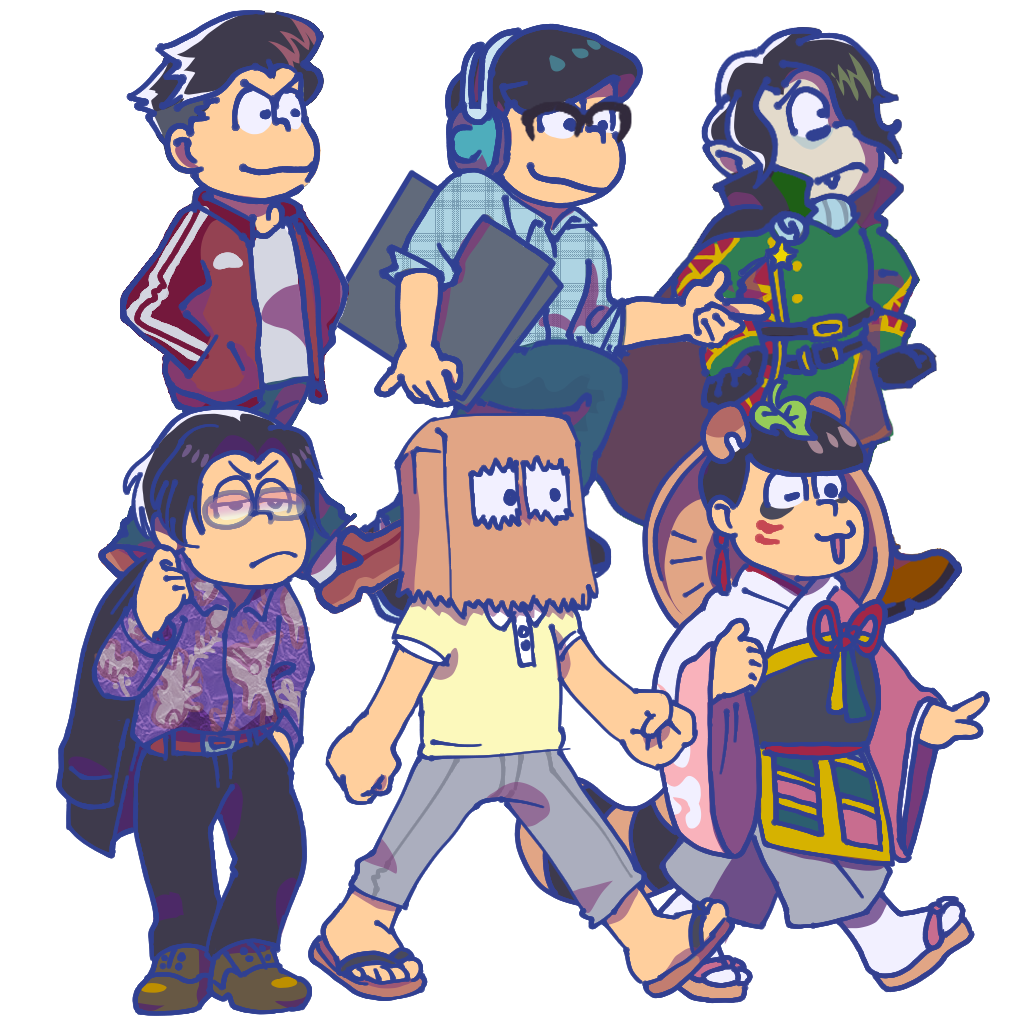
This two-year period is when the game was at its most popular and powerful: frequent, novel updates that could be fully accessed by F2P players. Arguably, this overlaps with the height of Osomatsu-san's popularity.
Many designs and stories released at this time had since been revisited or iterated on in future updates.
The dates used here mark the releases of the [Matsuno Quest] series and the [Bicycle] series, as everything between these two series could be easily obtained through gachas or scout tickets. Hesokuri Wars did seem to make a strong delineation between these and future series.

The game's first major update. The version change introduced new features as well as rebalancing the gameplay somewhat. Additional features such as achievements, the NEET Resume, and Konnichiwork were rolled out in 2.x updates.
Interestingly, only a month and a half after the 2.x release, the official Hesowars Twitter began to hype up the development of version 3.
It stands to reason that development of version 2.x began in response to Osomatsu-san's immense popularity.

In the beginning, about half of the designs used in Hesowars came from other Osomatsu-san media. For instance, the 「EXPO」series elaborates on the key visuals of the Osomatsu EXPO event. And of course many series are direct adaptations of episodes of Osomatsu-san!
Some designs were closer to collaborations, though. The「Kimono」,「Working」,「Date Clothes」and 「Formal Wear」series all borrow outfits from Yahoo! online games put out by Hesowars' production company, DLE.
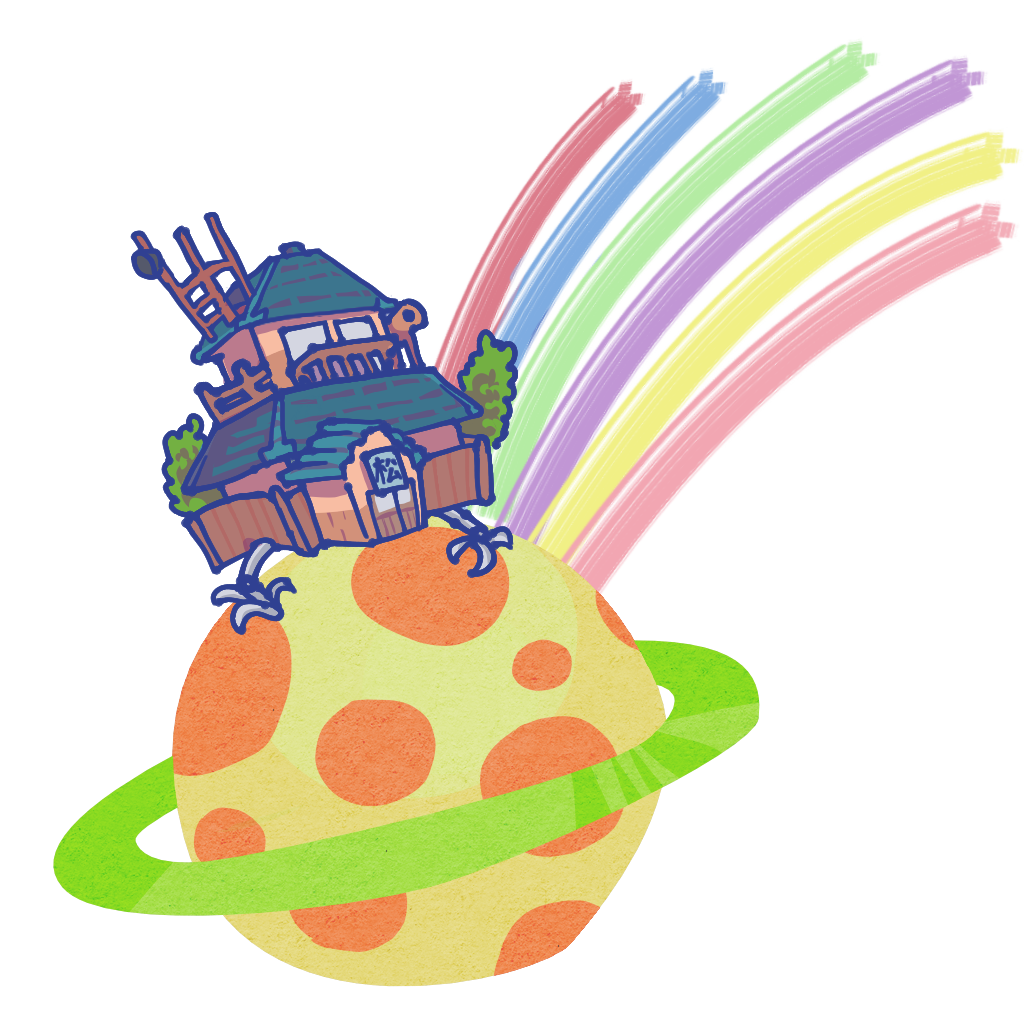
In the summer leading up to The Big Update, Hesowars made a point of chaining its story events together, with...
...all happening one after another, partly in a bizarre 'outer space' setting. Each story ended with a 'to be continued' hinting at the next story's theme, although as you can tell from the list, they didn't have much in common.
Note that these events, while mostly released in chronological order, were broken up by other story events (Franken-neet, Denki Mystery) where the brothers appear as not-quite-themselves.

Miniature versions of the sextuplets first emerged alongside [Ichimatsu: Prince], and would go on to appear throughout 2016 and 2017.These little friends showed up in all kinds of situations.
The one thing unifying all of these appearances is Osomatsu's apparent laziness, as he usually sits on the sidelines as the others attack.

Many Osomatsu-san app games had launched in 2016, and by the end of the year they were beginning to synthesize with one another. This was made official by the Neet Fes event, which spanned several game apps.
The first Neet Fes was a crossover event between Tabimatsu, Pazzmatsu, and Hesokuri Wars. Each game opened up a limited-time gacha adapting iconic designs from the other two - Hesowars was represented by its' [Prince] series, Pazzmatsu by its [Marching Band] series, and Tabimatsu (then relatively new) by its original [Travelling Clothes].
The second Neet Fes featured a shared「Valentine's」 design series between even more app games: Tabimatsu, Pazzmatsu, Hesokuri Wars, Osomatsu Sanpo, Osomatsu Party, and Matsuno Family Dependents. This design, featuring the sextuplets in a chocolate-coloured, candy-themed Valentine's Day suit, even made it to physical merchandise.

Hesowars' New Years 2017 event, イヤミカート 新春特別杯 closely followed the 'Iyami's Counterattack' episode of Osomatsu-san. At its conclusion, staff promised to give out an ULTRA SUPER GREAT present, which was... Shonnosuke Hijirisawa's 16 brothers, in accordance with the true winner of Iyami Kart.
Hijirisawas taking over Hesokuri Wars would become a running joke over the years.

2017 kicked off with a series of 'No Sextuplets Allowed' restricted stages, including one that acted as an in-game poll to determine which side character would get a special 4★ release. Each stage cleared acted as a vote for the (non-sextuplet) character in the first slot of the party.
Totoko won the poll by a significant margin, with Nyaa Hashimoto and Shonnosuke Hijirisawa coming in a tie for second. After a tie-breaker round, all three characters became special additions to existing series: a variety of 4★ Totokos were added, Nyaa was added to the Steampunk series, and Hijirisawa was added to the Sweets series.
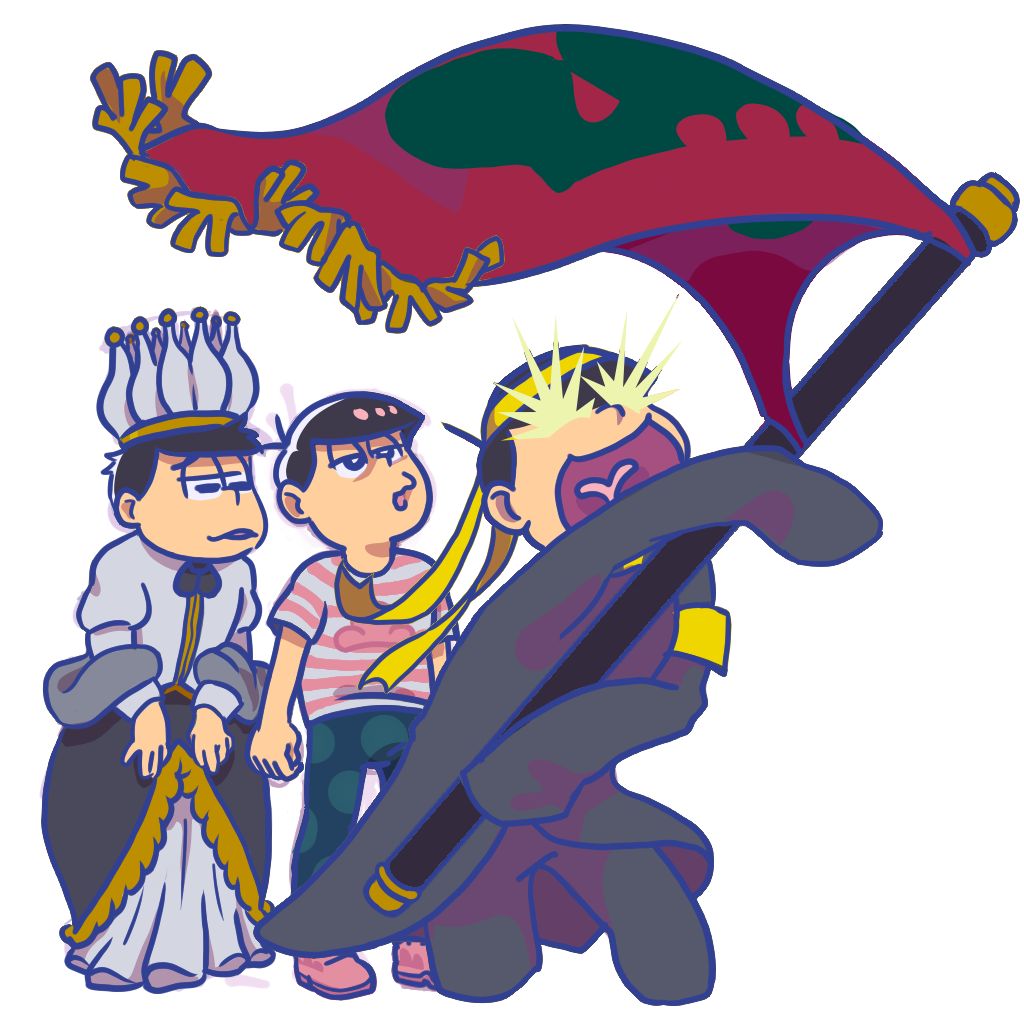
In 2017, collaborations extended to merchandise. The 「Osu!matsu」, 「Boatermatsu」, and 「Chess」 series are all based on real-life figurines sold by Banpresto.
Of these three, [Osu!matsu] was embraced most tightly by Hesowars. This series was readily available in the Gold Oden shop and was easy to obtain. When Kuzuneyland opened later in the year, the series got its own bonus mini-story through the 炎の熱血校舎 attraction.
To contrast,「Boatermatsu」and「Chess」series were... more or less one-time gachas. Neither of these series appeared in any future gachas, although the characters in each were available to redeem through Scout Tickets.
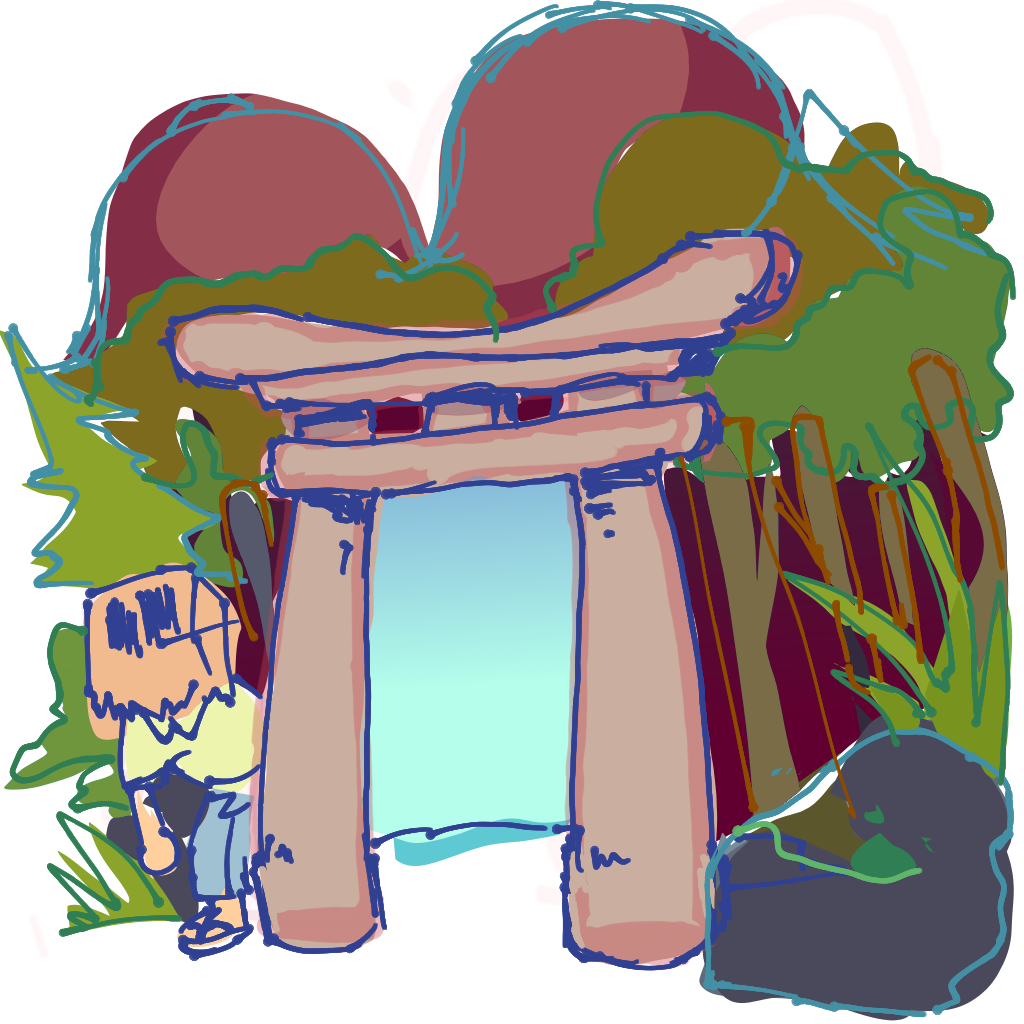
Hesowars took a bold step with its alternate-universe genre parodies with Denki Mystery, a loving send-up of prestige television, genre novels, and cult film. The story centres around a set of familiar-looking sextuplets separated at birth who are brought together by mysterious forces to investigate the strange rituals held in the mountainside Akatsuka Village.
Arguably, these alternative versions of the Osomatsu-san cast are the definitive face of Hesokuri Wars.
Since the initial release of Denki Mystery, the setting of Akatsuka Village and its unusual cast of characters have been frequently revisited in follow-up stories and lavish character series. The long-running Denki Mystery story consists of 11 main story chapters, 12 extra episodes, and 10 premium character series.
There were also 4 Joshimatsu-led spin-off stories, 六ツ鹿(むつしか)家の女たち , the two-part 家政婦が見た少年たち! - 小さな影, and お母さま.

A short-lived phase where popular 3★ designs were revisited and souped-up into deluxe 4★ versions.
While this foreshadowed design trends that would come later in the game's lifespan, it was novel at the time.
Hesokuri Wars had always been region-locked to Japan, but staff was perhaps aware of a non-Japanese userbase as official English, Korean, and Traditional Chinese translations of the Hesowars app were released worldwide in the fall of 2017.
The international versions of Hesokuri Wars were based on the Version 2 engine, and seemed to have been released as-is. There were no story events, so play was restricted to the original 100 main stages and the cash gacha. Players in outside markets were able to contact staff support for a special transfer bonus of 500 diamonds should they choose to give up the original for the localization, but this was not embraced by players as it would have meant losing progress when transferring between the apps.
Despite this page being in English, I have actually not played the English version of Hesokuri Wars so I can't speak to its quality or any of its features.
The international versions hummed along for a while with no major updates until their closure in August 2019.

Hesowars released its second major update to correspond with the airing of the second season of Osomatsu-san. While the lead-up to the release teased a 大型アップデート or 'Big Update', the release also renamed the game to 'Now on Sale! Osomatsu-san's Hesokuri Wars ~Attack of the Neets~'.
This release was massive and added a lot of new features to the game, including Kuzuneyland, flag collection and gacha, the NEETomodachi program (or buddy list), NEET Resume cards, and a new story system. This was more or less the definitive version of Hesowars.
The game ran on version 3.x for almost two years.

The Version 3 release came along with a major asset re-draw. The sextuplets all recieved new base poses with significantly more detail than before.
The re-draw might have been influenced by updates to the characters' model sheets for the second season of Osomatsu-san, which subtly shifted the sextuplets' build from from loose and noodle-y to something more stocky and solid.

Around this time, Hesowars' stand-out feature was its variety of original designs and settings. However, its method of telling stories was restrained by its pop-up system, which could only display a few short lines of dialogue and a generic sextuplet portrait. This changed with the version 3 update, which implemented a new system for story events described in the release notes as a "Scenario Power UP!".
This new system allowed for a 'visual novel' style of storytelling, allowing for different characters - including different poses - and backgrounds to be displayed alongside the dialogue. Music and SFX could be also be changed to further set the scene.
The テレビ赤塚 生放送! story event was written with the deliberate intention to showcase this system's capabilities.

After much hinting, Kuzuneyland opened alongside the Version 3 update. This shitty theme park served two purposes.
Mechanically, Kuzuneyland added a new game mode and a whole host of associated features. Players were able to decorate and tend to their own theme park by drawing Attractions and Decorations in a dedicated gacha. They could visit the theme parks of other players - and, if they were impressed, they could send them a cute little いい or even make a NEETomodachi request!
On the story side of Hesokuri Wars, Kuzuneyland provided a common setting for the sextuplets' misadventures. Over time it was revealed to be filled with VR pods and staffed by robots, although there were other secrets to be found in 2020.
Kuzuneyland Attractions also served a variety of purposes. On the combat side of the game, Attractions could replace the Matsuno House as the player's home base to provide major stat boosts and other bonuses. Storywise, Attractions had a mechanism to display stories up to three chapters long, allowing for series that had launched without stories to have a moment in the spotlight, or for expansions on already-popular settings.
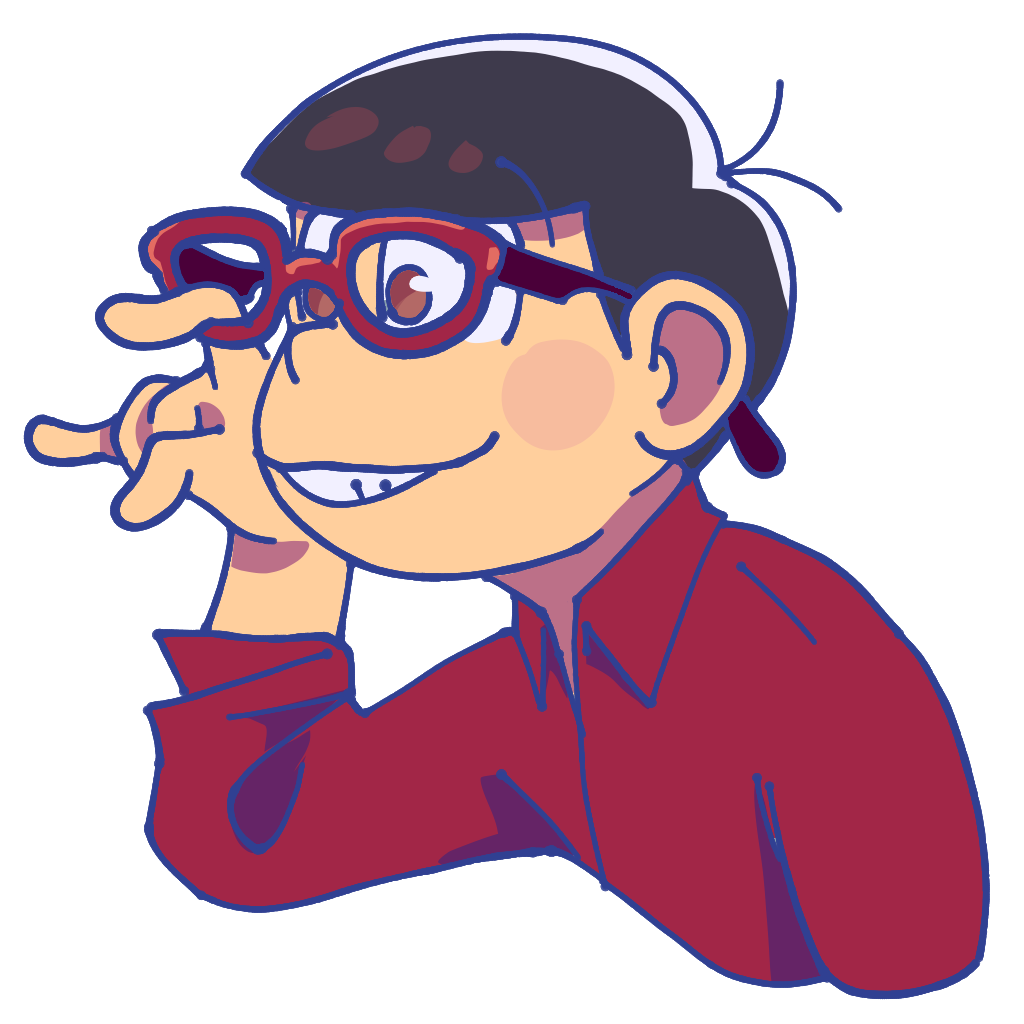
One of Hesowars' more idiosyncratic design choices was a short-lived but striking series of decisions to put glasses on Osomatsu. Glasses contrast with his immature personality, right? Or, more likely, they imbue a responsible air to him that would otherwise be completely absent.
Osomatsu became a megane for...
The glasses briefly resurfaced again, near the end of 2019. [Osomatsu: Extreme Wolf in Okinawa] and [Osomatsu: Jazz Band], both meant to be slightly more mature and sophisticated than the standard Osomatsu, wore thick plastic frames.
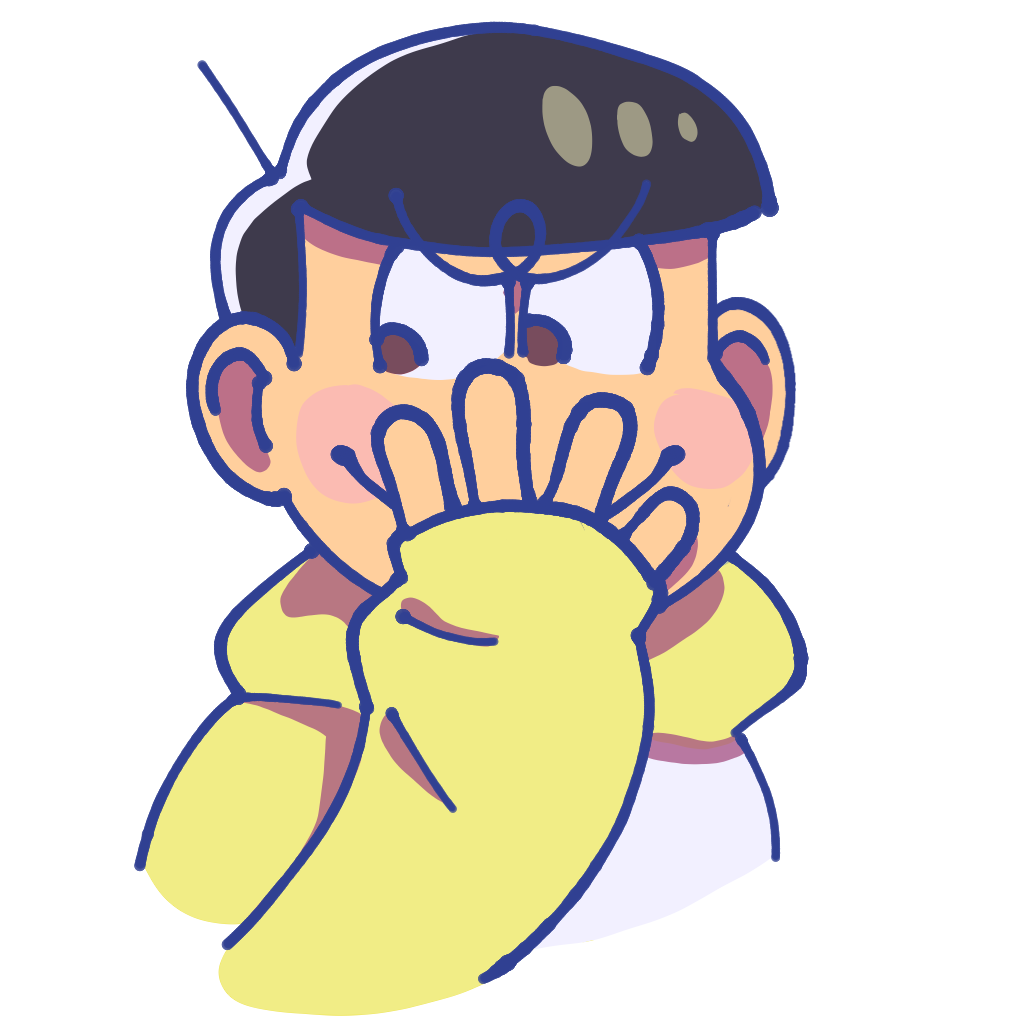
Jyushimatsu's face and expression generally do not change, no matter the situation. However, starting with [Jyushimatsu: Reaper] in early 2018, there was a long string of Jyushimatsu designs where his mouth was closed or covered. This may have been kicked off by a throwaway line in the 名探偵イヤミ 六人の怪人(クソニート) story, where Osomatsu instructs Jyushimatsu to close his mouth.
This trend was broken with the [Gangster] series, where Jyushbert's mouth opened a little too much in his attack motion.
When I look at him, I think, 'He is going to suffocate!'
Shortly after the airing of the depressing season 2 episode 'Iyami-san is Troubled', bitterly jealous Showa 大STAR Iyami hijacked Hesokuri Wars for himself. Watch the trailer for the game here.
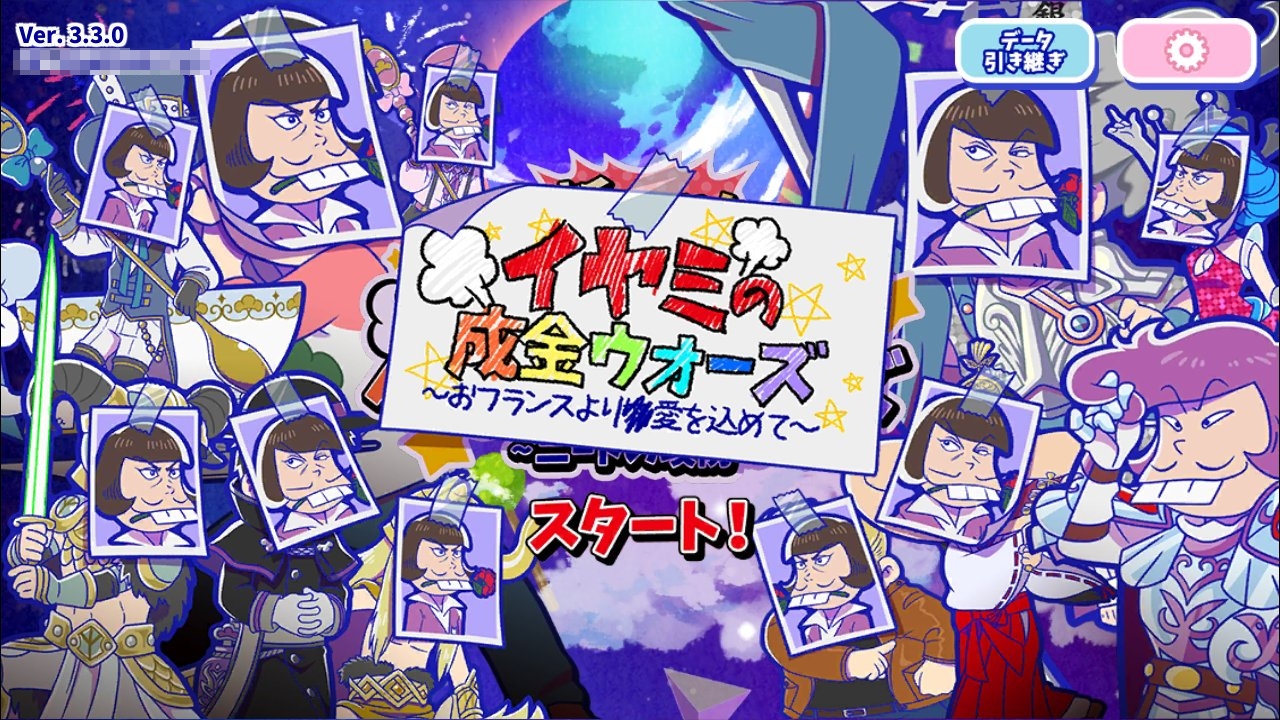
The game was briefly renamed to 残イヤミの成金~おフランスより▨愛を込めて. There was also a special 183-diamond gacha where players could only draw allied Iyamis, including the fearsome Iyametaruder-Z.

After two and a half years, Joshimatsu made their debut in Hesowars with the 「Lady Prisoners」 series and 女囚ブライド 復讐の恋文 story.
Joshimatsu would go on to appear every so often in a fanservice-y way. They starred in multiple story events and would feature in special seasonal design series that emphasized their femininity.
The designs for the 4★ Joshimatsu series... Whew. Someone on staff was really looking out for the gals. Thank you Hesosensei.

After two years of consistent and high quality updates that could feasibly be accessed without ever spending money, Hesowars introduced a very familiar mobile game mechanic: cash-only gacha. Pretty much all new 4★ character series released in this phase could only be obtained by spending real money.
This was coupled with updates slowing down a bit. New story events became less frequent as old story events were re-run, and a set format for challenge stages - called Oshibari - was introduced.
This period of relative quiet matches up to the production, theatrical release, and spoiler moratorium period of 'Osomatsu-san the Movie'. Updates began to pick up once the film was out of theatres.
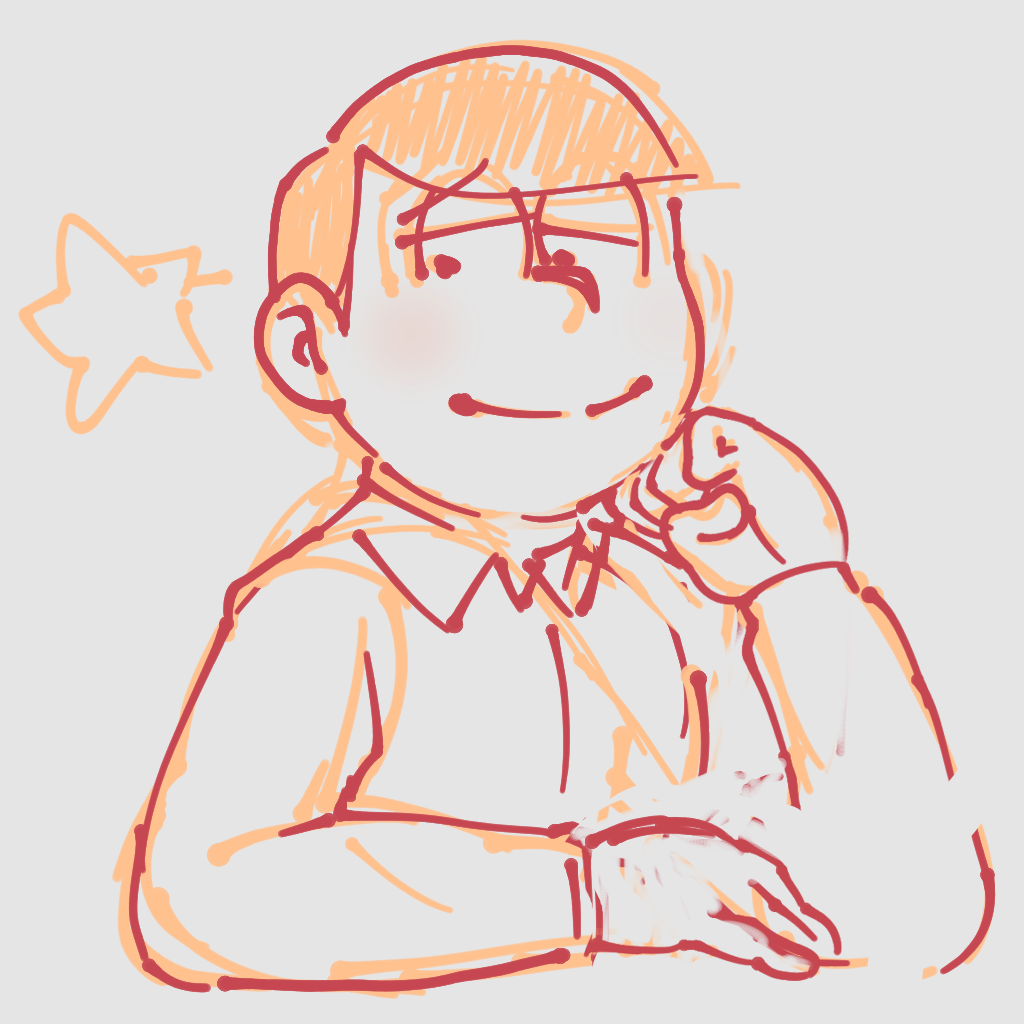
Slowly but surely, the third son's alter egos took on an appearance of disinterested confidence. (Compared to his actual persona of 'excitable nerd', this trend could be a realization of the ideal self.)
This design trend arguably began with the introduction of Chorosuke, the flower arranger's son. However, the energy displayed here really took a turn in late 2019, early 2020...

At some point, someone who really loves Choromatsu was hired to draw him for Hesowars. This was especially evident around the middle of 2020.
'Alternate' versions of Choromatsu tended to be the most aesthete. The recurring Matsu Noir, Yakuza/Extreme Wolf, Denki Mystery, Sweet Villain, and Jeweler M Choros all have a little extra care put into their clothing, expressions, and poses.
It's hard to determine an exact start date for this trend, as Hesowars appears to have had multiple illustrators, and it's obviously unlikely that they all have the same oshi.
This phase was short-lived, and only included two events: promotion for an F6 stage event (F6 1st Live Tour: Satisfaction) and a special Seiki K crossover story. Characters from this phase were placed in their own category in the character encyclopedia: 「Collab」.
Collaborations in Hesowars quickly turned back around into the Osomatsu-san franchise.
Osomatsu-san is no stranger to collaborations, and even earlier in 2018 had done crossovers with super-high-profile media like Ultraman and Sanrio. It's possible that the timing for the 'Collab' menu in Hesowars specifically was just not that good...

Some character designs featured companion which were later released as standalone characters, often offered as purchase bonuses when buying diamonds. These included...
There were also mini-character designs planted in other series, like the little helpers in the 'Egyptian God' series.
Quantifying this as a trend is kind of difficult, as lots of Hesokuri Wars characters might qualify as little guys - Esper Nyanko had been available from the beginning, for instance!
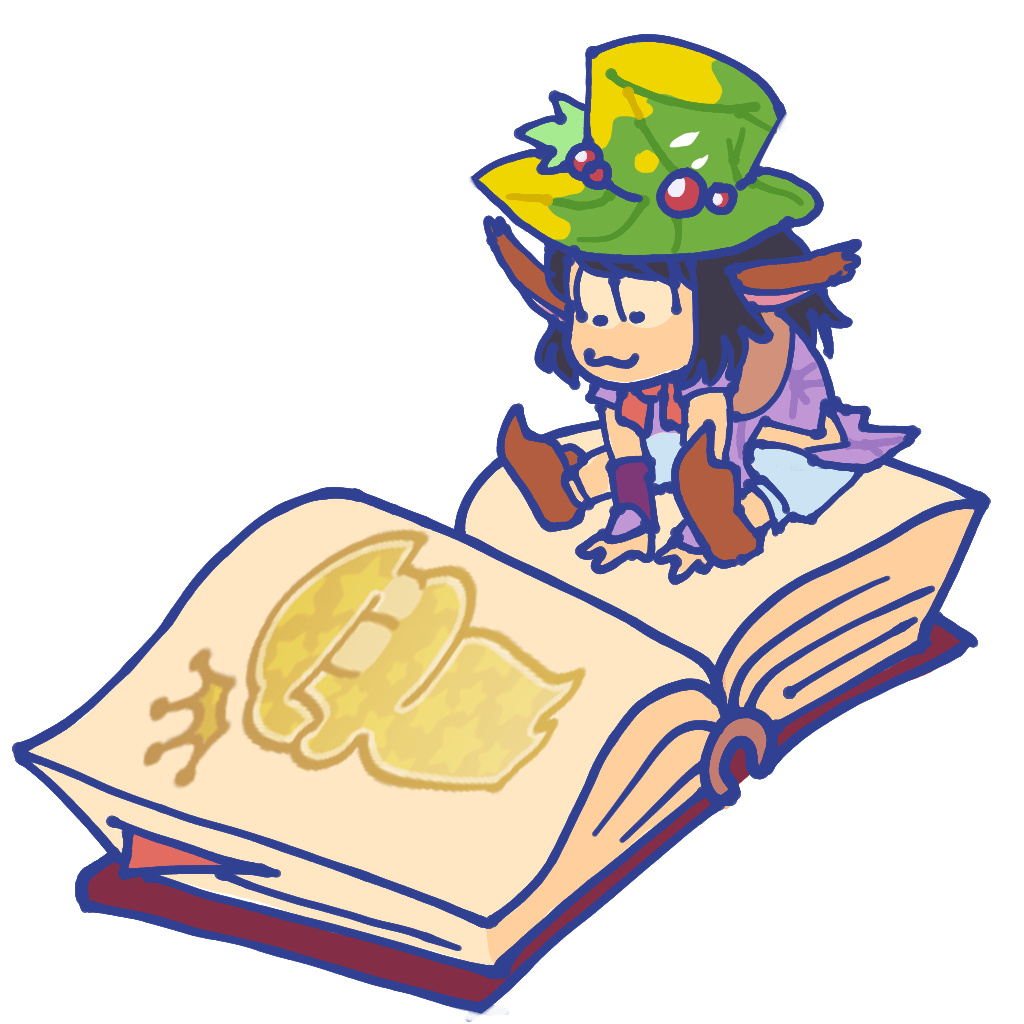
All design series in Hesokuri Wars had an implicit story to them, so this new event type meant to showcase new 4★ design series. While Hesowars had run lots of events with points but no story, the 4★ Stories were stories without points, prizes, or gachas.
The format was first introduced in conjunction with the 「Goblin」 series. Originally, completing all of the story stages would give the player 10 gacha tickets which could be used for a chance at one of the limited characters featured in the story. For later events, this prize was changed to 500 diamonds.
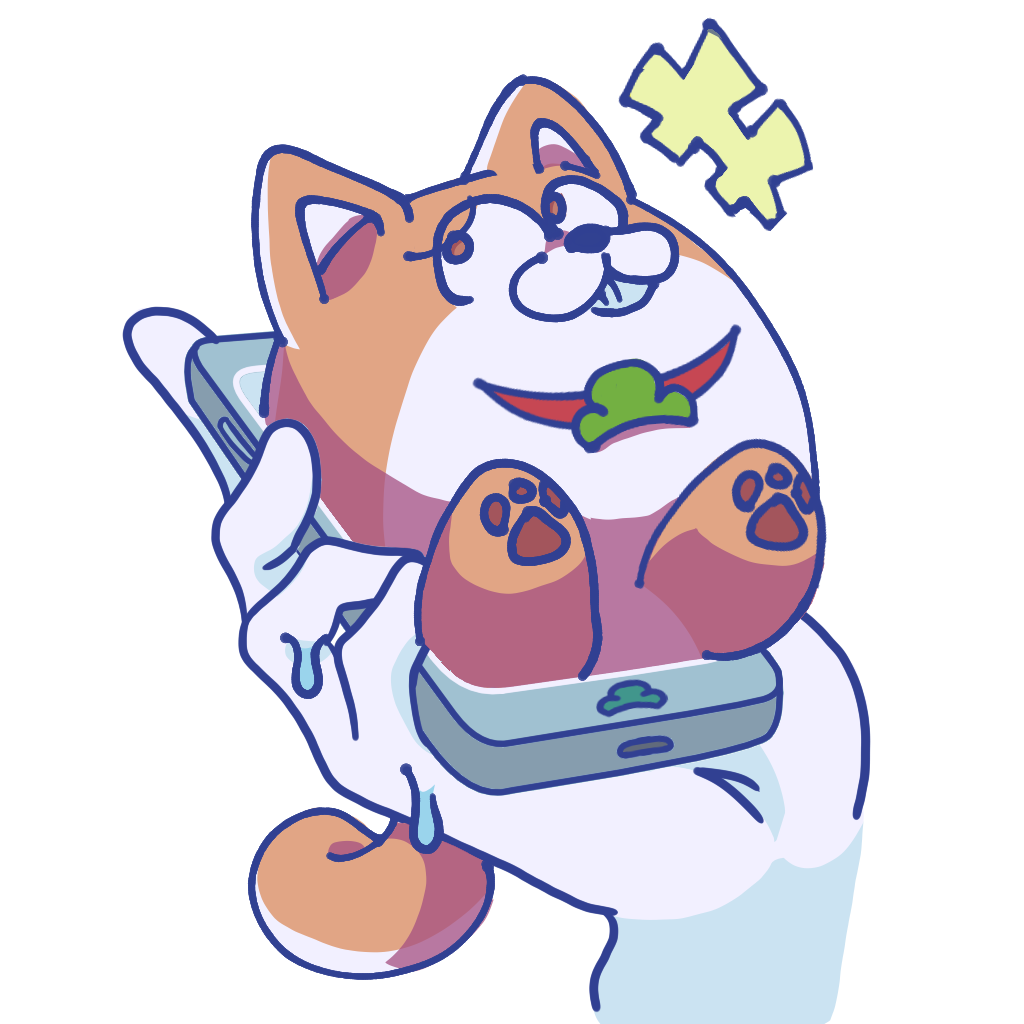
Matsuinu (literally 'Pine Dog') is a line of extremely popular soft toys that are clearly based on Osomatsu-san, but aren't quite Osomatsu-san characters. The doggies were first introduced in the fall of 2017, and have spun out into their own franchise since.
Matsuinu frequently crossed over into the various Osomatsu-san app games. In Hesokuri Wars, Matsuinu appeared as in-game characters, Kuzuneyland decorations, and even as the subjects of their own 4★ Story!
In-game, Matsuinu are creatures of peace. They don't seem to get hurt, and they don't attack enemies directly - instead, they disarm with their cuteness.
Aside from the television anime, Matsuinu and Hesowars are the two major supporting branches of the Osomatsu-san franchise. Collaborations between the two appear to have been mutually beneficial- for example, new Matsuinu merch frequently turned up in Hesowars, and Hesowars frequently tapped into Matsuinu for design inspiration - but may have actually been contractually obligated.

The real-life 'MATSUNOICHI' events were consistently popular throughout 2018 and 2019, so unsurprisingly the mascot costumes used in those events found their way into Hesowars. The first release was explicitly framed as a special collaboration to celebrate the game's third anniversary.
Throughout 2019, there was the occasional special diamond campaign where in-game currency purchases of only Y100 came with a complimentary Mascot Summer Kamen.
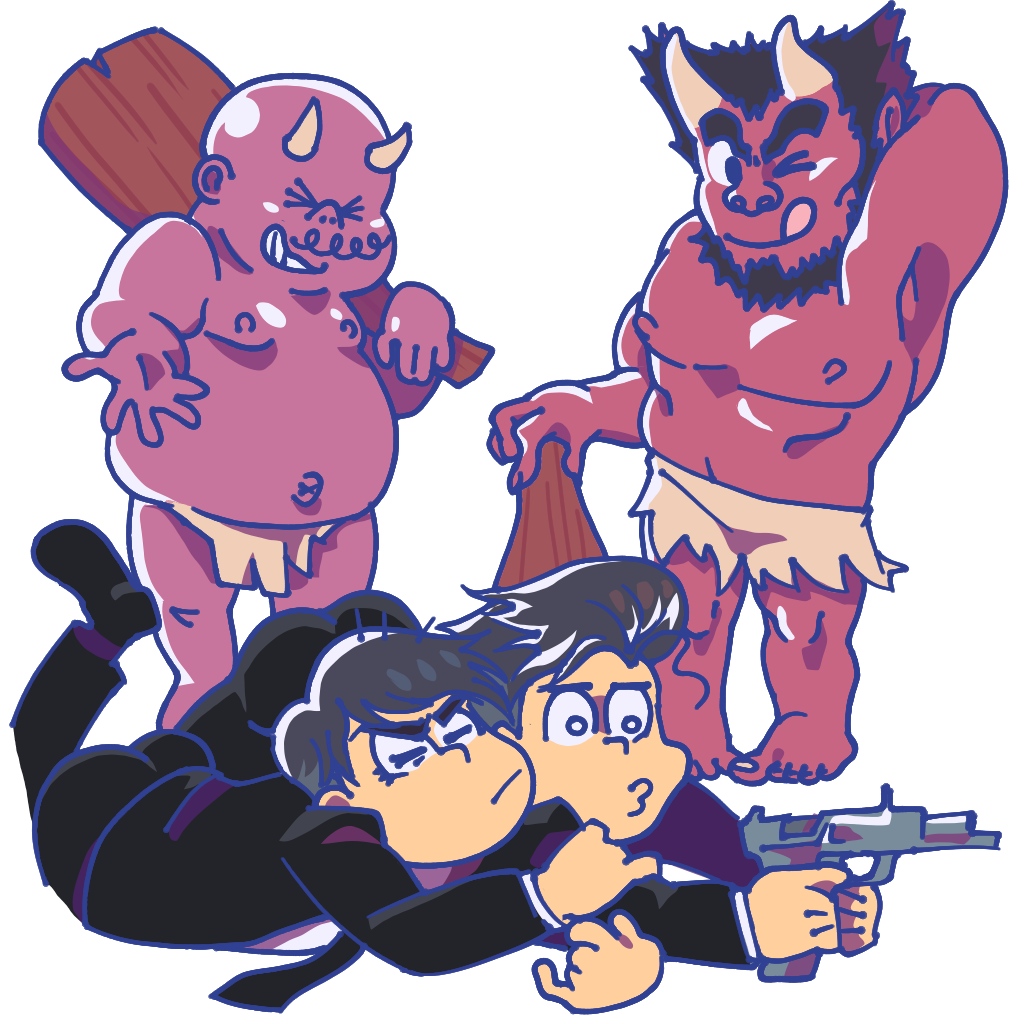
This one is perhaps difficult to explain to anyone not familiar with a protective fan culture.
The [Matsu Noir (In Hell)] series adapted poses and designs from the second season finale 'Osomatsu-san in Hell', with the the [Matsu Noir] characters shown pairing up to fight oni in Hell. However, in one case, they swapped the characters from Karamatsu and Choromatsu to Osomatsu and Karamatsu. This prompted shock and pushback from the playerbase, who saw this change as disrespectful to the original scenario.
Rather than adjust the (technically new) poses for the brothers, staff changed the designs of the oni so to create a new scene while respecting the original.
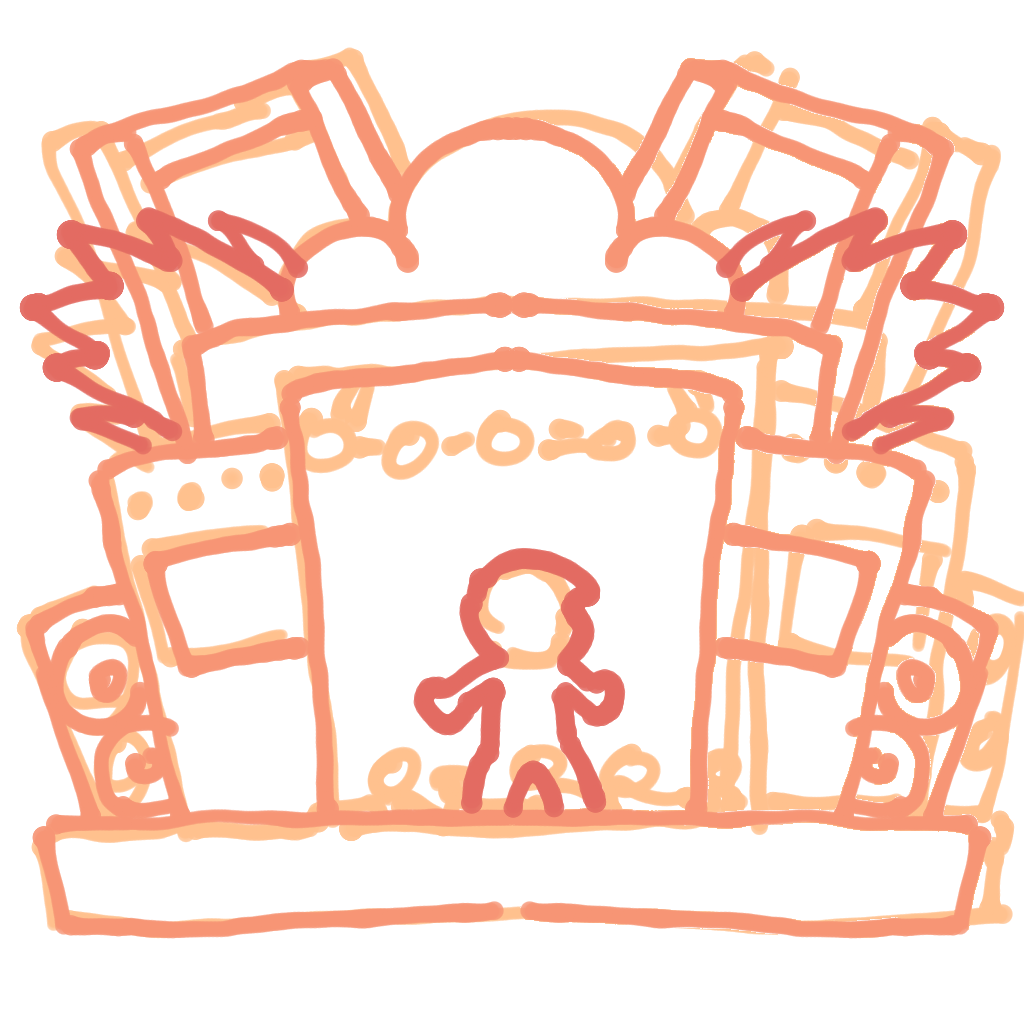
Summer tour with a ‘BAND’ theme. Each month the band would appear with a new visual (‘spooky’, ‘goofy’, and ‘future’). Users who drew in the paid gacha for each series could then redeem their ticket stubs for a special all-sextuplets band unit.
By the way, I don't recall the original band ever having been given a name? The sextuplets all have 'band' stage names, and in some appearances the band has a themed name, but that's it. SCRATCH THAT KARAMATSU SUGGESTS CALLING THE BAND MI6 IN THE FIRST STORY

Hesowars operated on 3.3.x for a really long time, but eventually ticked over to a fourth engine revision in 2019. I say 'engine revision' as version 4 mainly introduced features that made the game easier to play.
The big addition of 4.0.0 was an update to the NEET Resume system, which allowed players to decorate their profile with collaged images of the characters they had collected.
Around this time, story events and full series releases began to pick up again, and became much more frequent.
Version 4 may also have quietly expanded the game's combat system, as many characters and series released after the revision had special 'skills' not seen before.
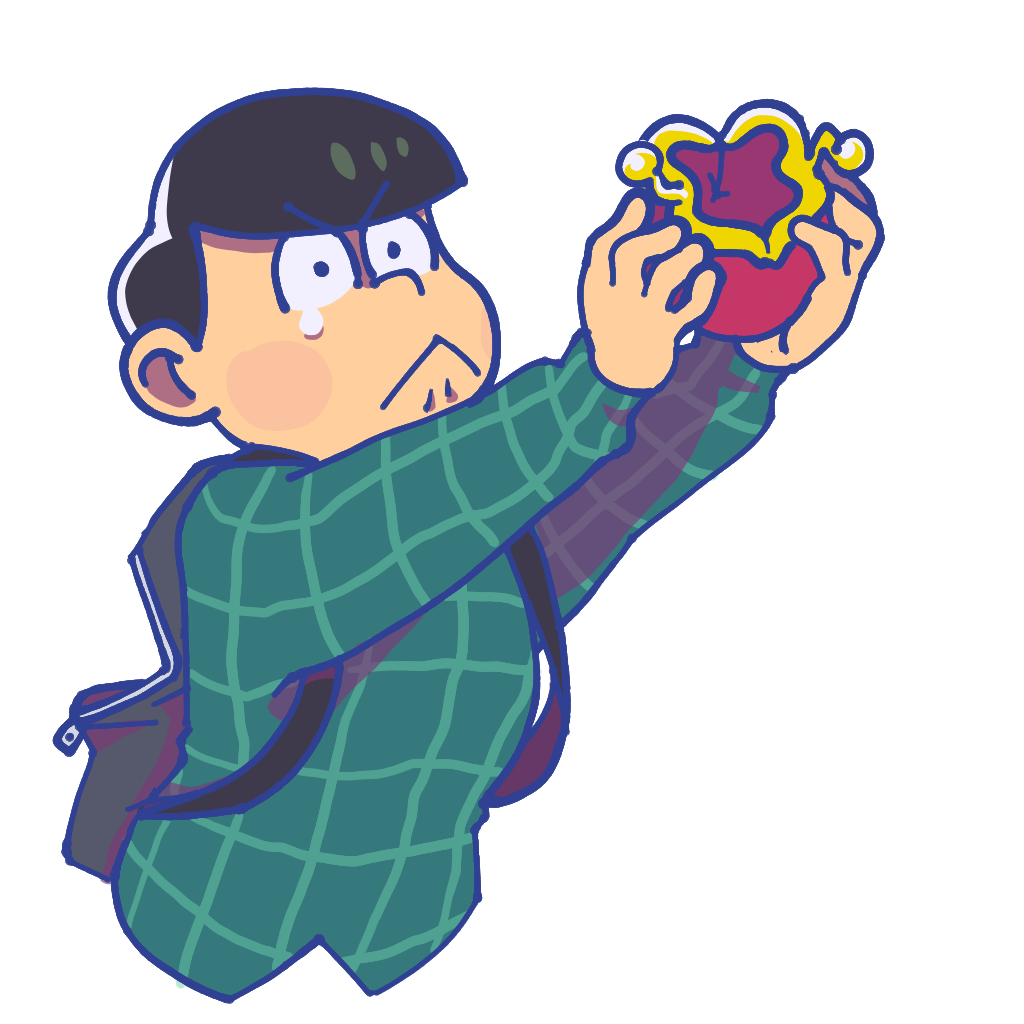
After about a year of locking all new character releases behind a pay gate, New Gacha Tickets were introduced as a way to 'rebalance' the game for F2P players. These tickets could be exchanged for a chance to pull for new characters at exceptionally crappy odds: 0.05% per character, or 0.3% per new series.
After less than two months, these tickets were replaced by a more expensive version of the regular gacha (2000 diamonds to pull rather than the typical 500.) Even more time after that, the limited gacha dropped to the normal price.
Just look at this. Anarchy.

This splash image was accompanied by a similarly maximalist new title theme, 松たり難く松たり難し! It wasn't like this all the time, though. Also starting in October 2019, the launch screen would periodically change to celebrate holidays, story anniversaries, and new events.

Shortly after the 18yo versions of the Matsuno brothers were added to Hesowars, a string of new story events went to great lengths to justify further portrayals of the characters as children. This included 'alien parasite that takes on the appearance of a host parent' and 'animated puppet'. Ultimately, none of these new designs were actually children, although later on a younger version of Totoko would appear in the care of the Phantom Thieves.
The 'damage' motions for vulnerable characters are relatively mild, and only show the character being pushed backward rather than getting hurt in any way.
The convolutions here might have been the result of friction between the high level directive to keep 'Osomatsu-san' and 'Osomatsu-kun' distinct from each other and a moneyed audience who is receptive to cute domestic scenarios.

Hesowars made a big production out of its fourth year of service with the red-carpet Akatsuka Awards. Players were invited to vote (in a Google form lmao) for their favourite stories, characters, and background tracks over the years, and the results of the player poll were announced as part a retrospective story event, 俺たち監督ブラザース!.
The last line of the story event was 'TO THE FIFTH YEAR' which was so nice.
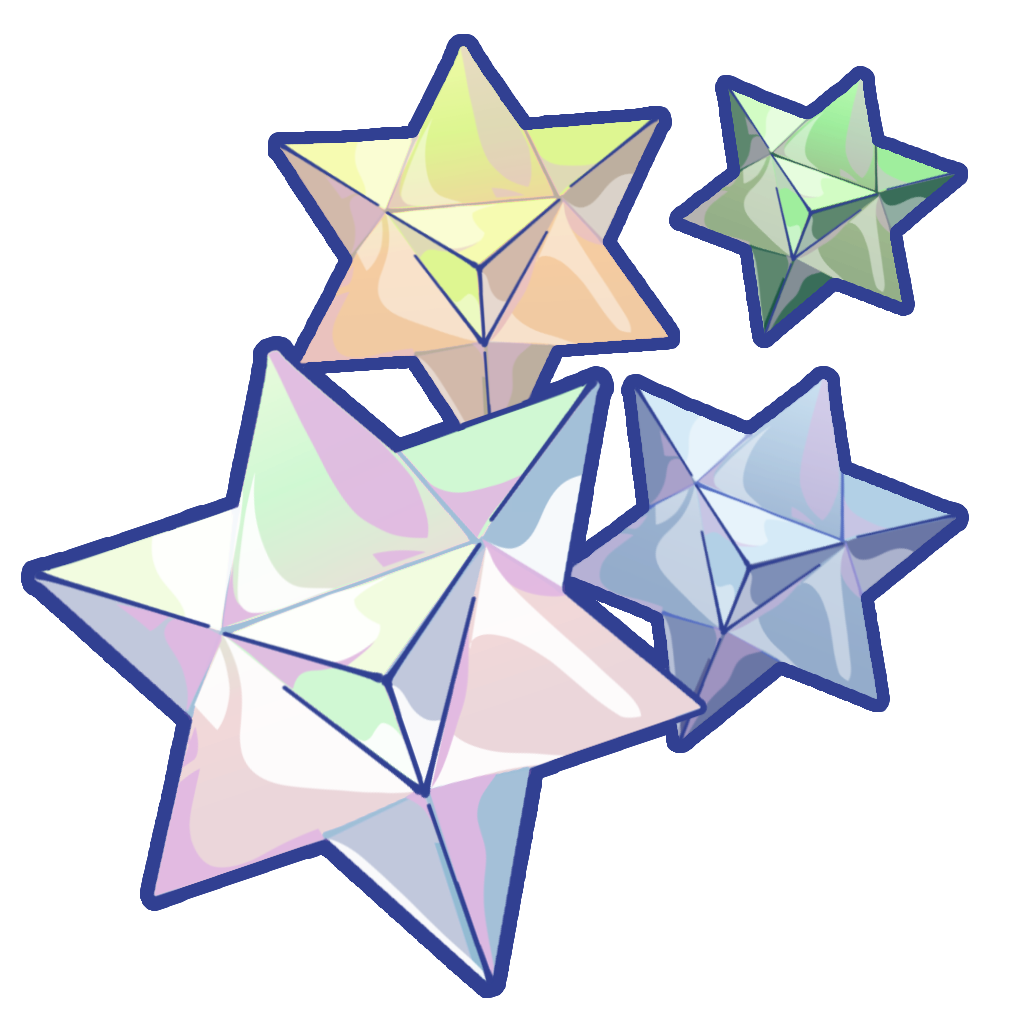
The ウィザード・オブ・クズニー event unearthed the purpose of a mysterious new mineral: Emotite!
Emotite served two purposes: to tie together several in-game mechanics as a reward for longtime players, and to provide a unifying thread between all of the events and characters in Hesowars.
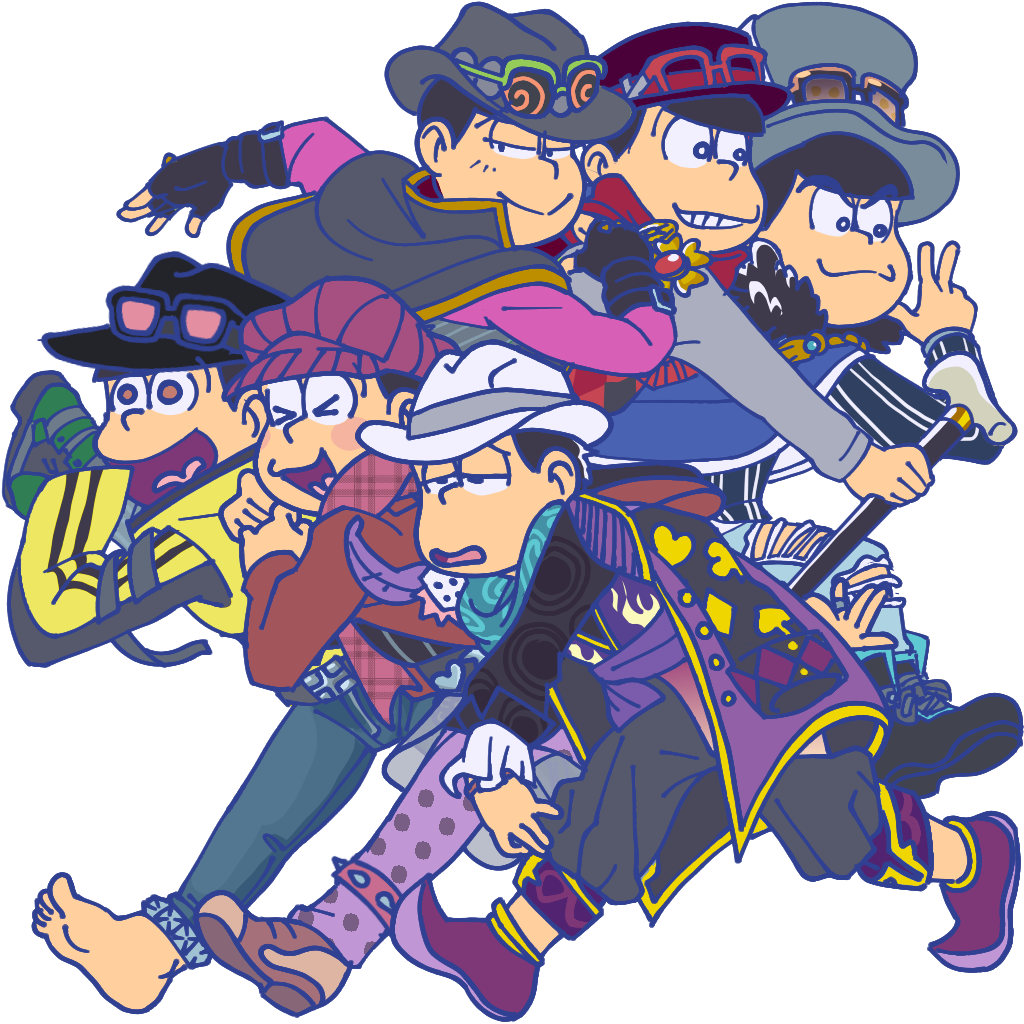
While Hesowars had always been self-referential, 2020 kicked off with a chain of events and design sets that explicitly tied all of the stories and series together. From there, the game's designs and settings referred to each other and overlap at a pace that is dizzying to consider. The design trend probably reached its apex with the 「NEET's Life Exhibition」 series, where the characters were dressed in stage costumes of the most iconic designs of past years.
By this time, the game's pretenses of vulgarity were almost completely gone. Many designs emphasized the appeal of the Matsuno sextuplets - whether they were cute, cool, powerful, mysterious, or any other qualities that are usually not associated with being an unemployed piece of shit - over the raunchy comedy of Osomatsu-san.
Of course, the reason for this is obvious from a capitalist perspective.
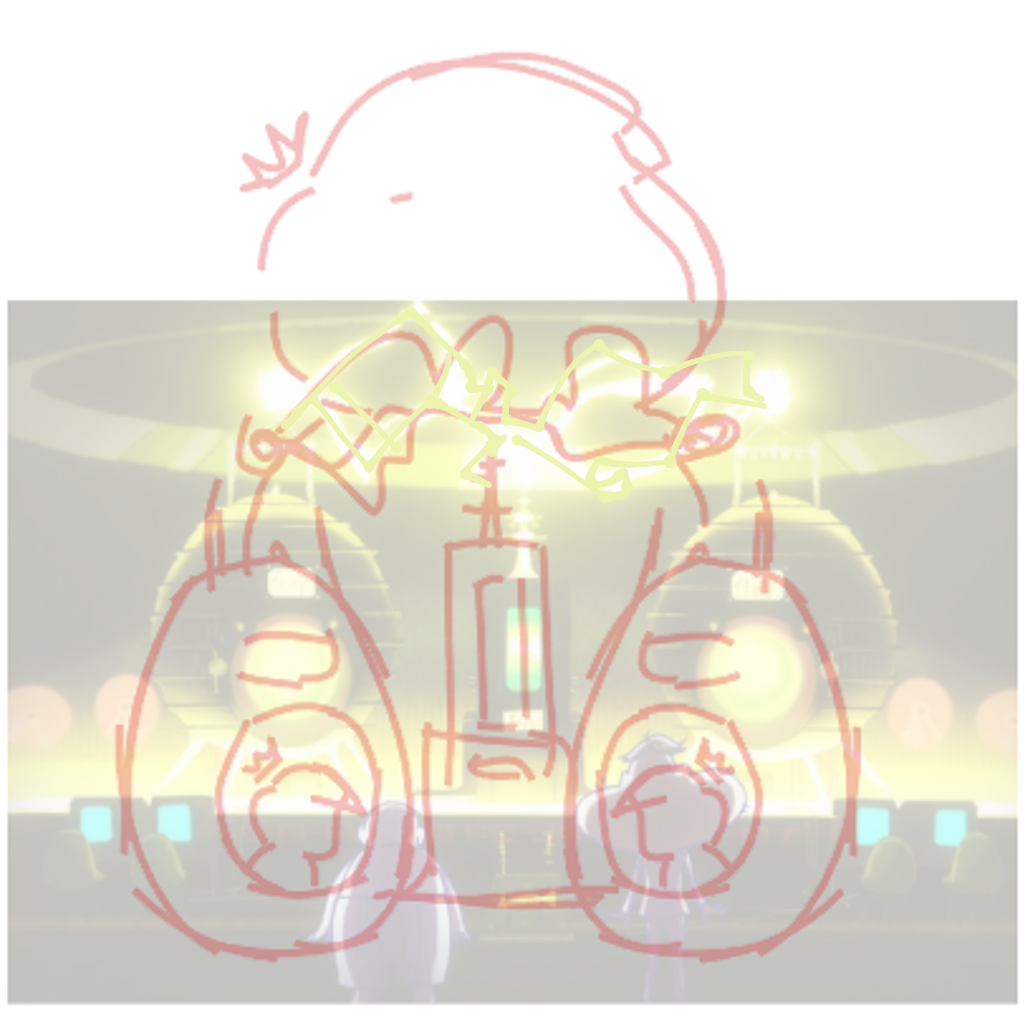
After emotite-as-a-plot-point was introduced, and the 'multiverse' model for the stories established, Hesokuri Wars began to collapse upon itself.
While Hesowars had always been self-referential, 2020 kicked off with a chain of events that explicitly tied all of the stories and series together.
From there, the game's designs and settings referred to each other and overlap at a pace that is dizzying to consider. The design trend probably reached its apex with the 「NEET's Life Exhibition」 series, where the characters were dressed in stage costumes of the most iconic designs of past years.
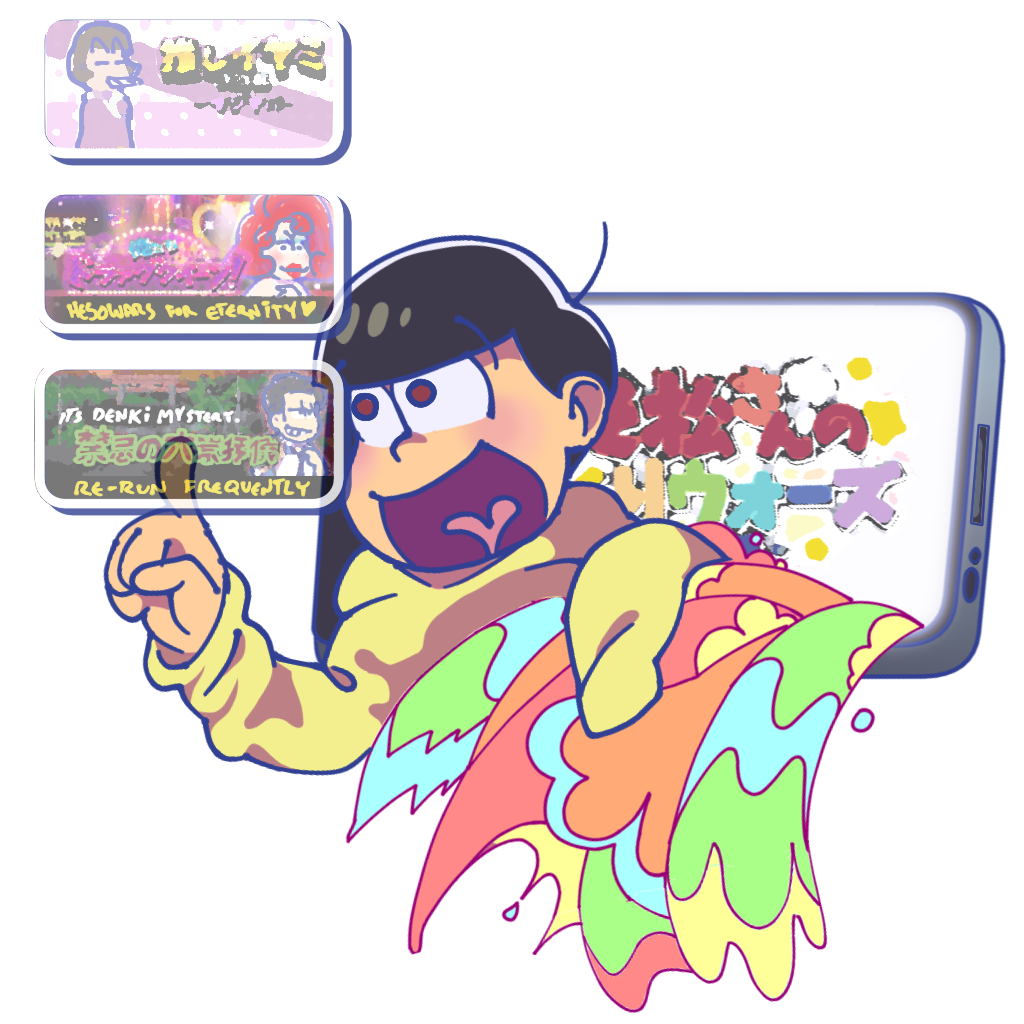
The fifth iteration of Hesowars was another massive change, although not quite on the level of the version 3 release.
Version 5 introduced a complete UI overhaul,further mechanical changes to make the game more user-friendly, 'event shops' in addition to the event gacha, a new experience mechanic to encourage the use of different characters in battle, a series of 'Everyday Stories', and giant balloons in Kuzuneyland.
By this time, Hesowars was the only Osomatsu-san game still standing - or at least, still receiving live service updates. The game's name therefore changed to reflect its longevity - it became 'The Original! Osomatsu-san's Hesokuri Wars'.
It's possible that ownership of the game shifted between studios around this time. The logos shown at boot changed and so did the game's PR and communications strategy.

Along with a new interface came a new, but not all that unfamiliar monetization strategy: a monthly subscription program. The Premium NEET Pass was a 480Y per month subscription pass to Hesowars. Passholders would receive monthly scout tickets, bonus NEET resume titles, boosts to in-game currency, and 'premium stickers' that could be exchanged for 4★ characters.
Not the BEST deal but pretty standard app game stuff.

Hesowars ran a series of fun little quiz games to hype the upcoming third season of Osomatsu-san. Each week, there would be a new true-or-false trivia question to answer about the the world of Hesokuri Wars, or eventually, that week's episode of Osomatsu-san!
The quiz system was a repurposed gacha with only one possible character to draw. Players would answer the question by pulling in the 'True' or 'False' gacha, where they would recieved a Hijirisawa with a placard reading either ○ (correct answer) or ✕ (wrong answer). At the end of each quiz series, the quiz Hijirisawas could be sent off into an special limited stage to win diamonds and special quiz-relate titles for the NEET resume. (As you could imagine, ✕ Hijirisawas were weak while ○ Hijirisawas were strong!)
There were also some Twitter campaigns to encourage players to post screenshots of their ○ Hijirisawa collections.
The questions were sometimes pretty tricky. The one that stands out in my mind is "True or false? Jyushimatsu says '失礼します' XX times in 'Job Interview'."
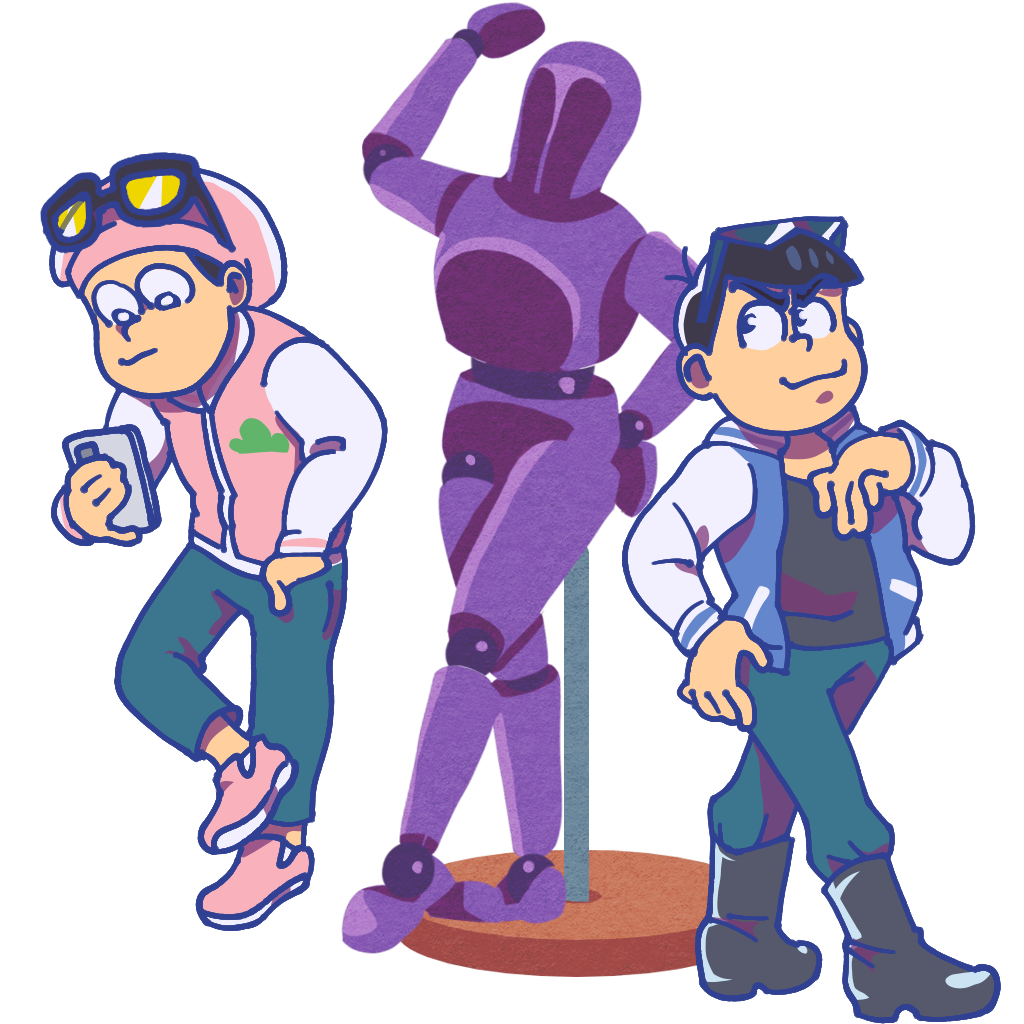
Just like in season 2, new character sheets brought a new series of base poses to Hesowars. This revision was not so drastic, though. Although the character templates were clearly redrawn, many of the poses are reminescent of previous poses.
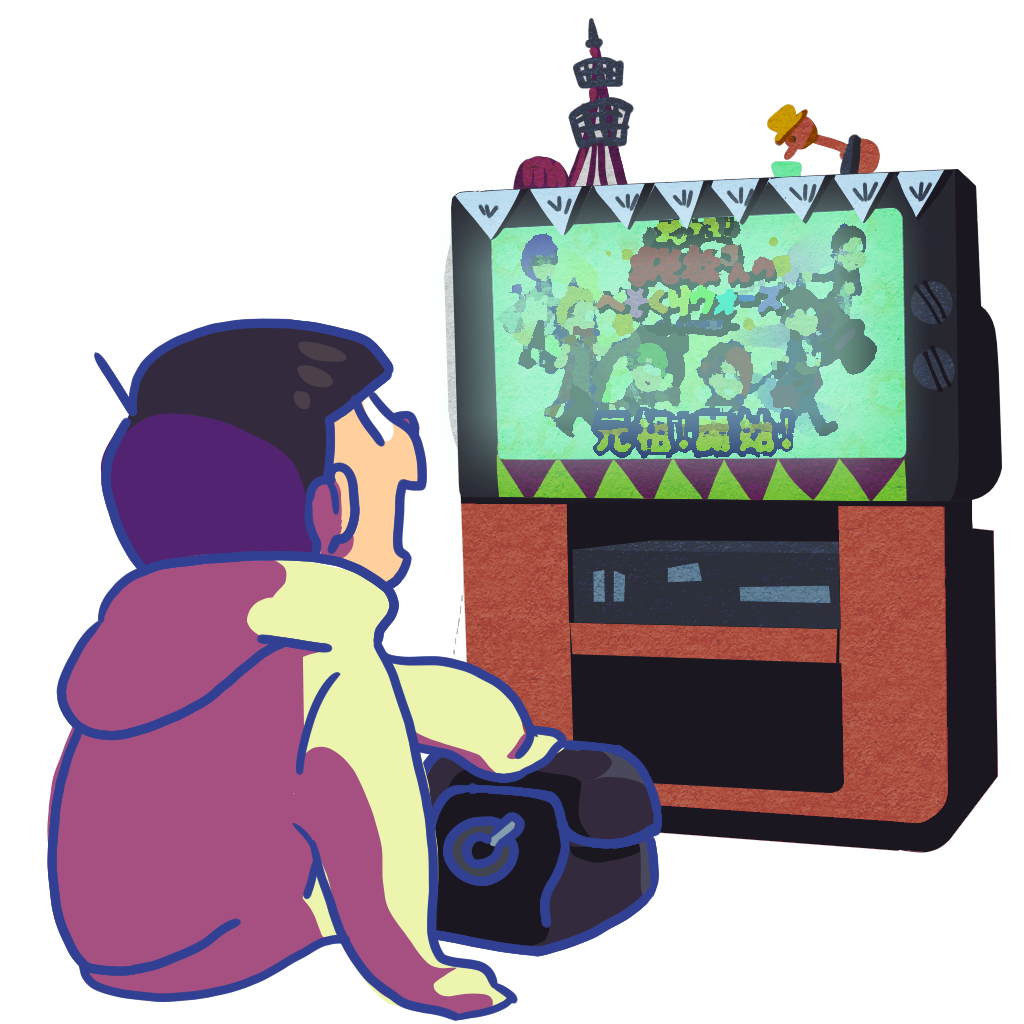
Hesokuri Wars advertised itself on TV... Of course during the Osomatsu-san broadcast.
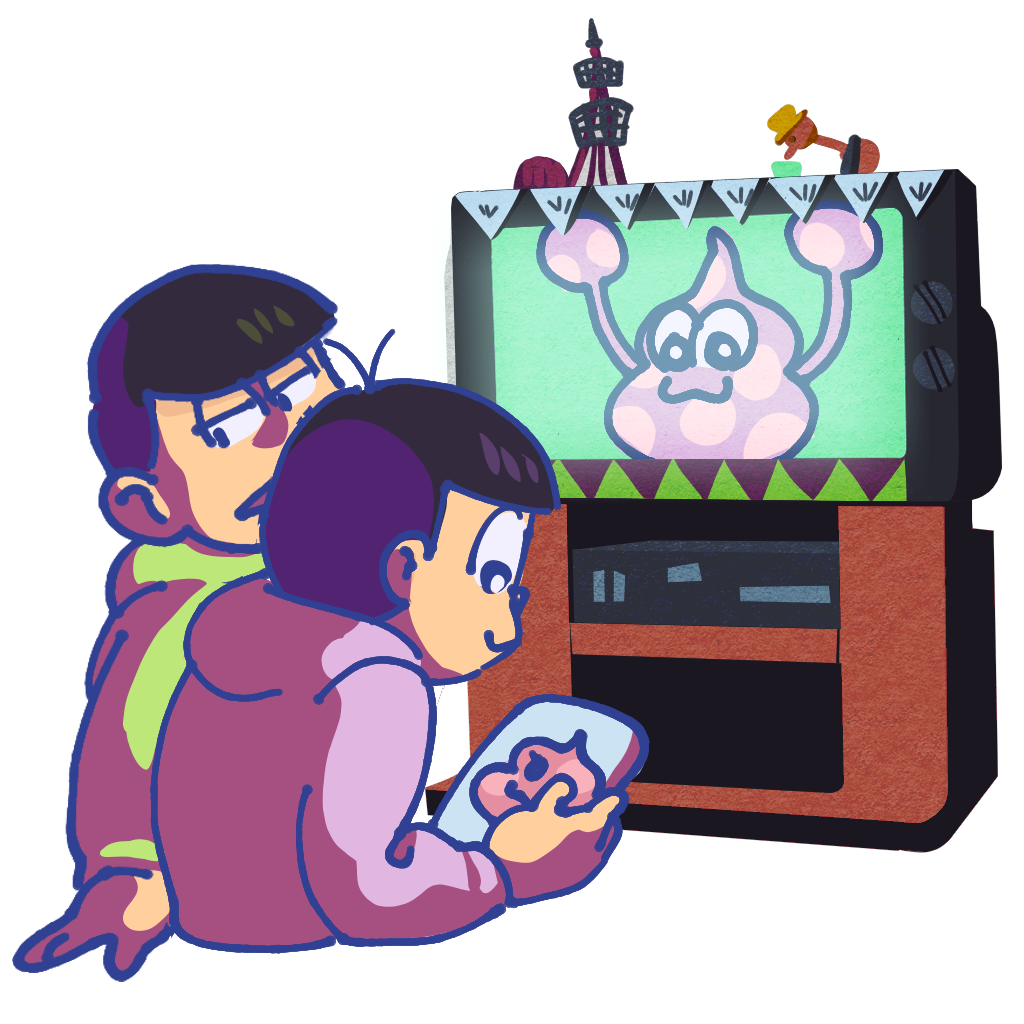
Hesowars readily kept pace with the third season of Osomatsu-san while it was airing by adding characters based on new episodes. At first, designs were chosen to be adapted via Twitter poll, but by the end of the second cour, they were being added nearly every week, sometimes even concurrently with original design series.
Throughout the first two seasons, characters lifted directly from Osomatsu-san were slotted into four design series called 「Popular Episode 1 - 4」. In the 'Popular Series' era, though, the selections were not so discriminate, and new series often included the same character multiple times in different poses.
Much of the time, Hesowars was able to add more detail to these character designs than could reasonably included in a TV anime production.
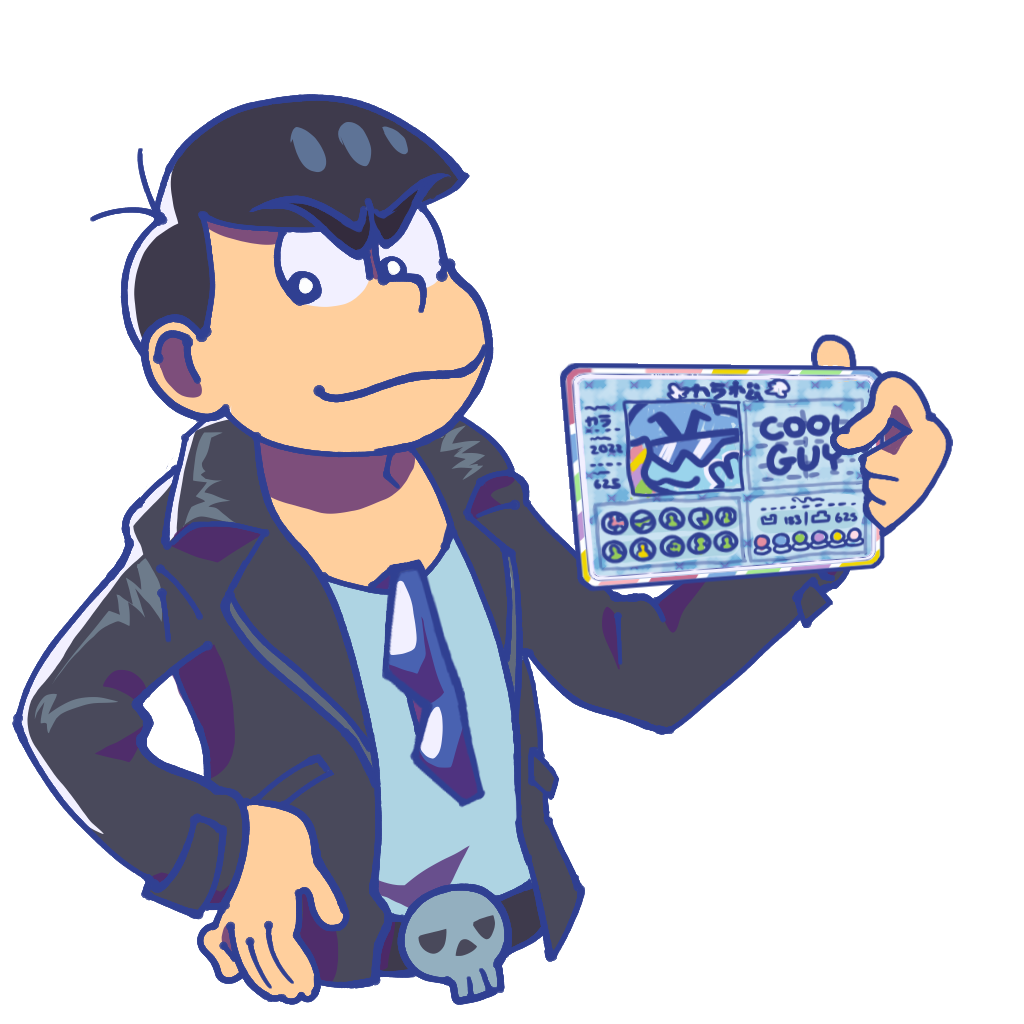
Once the new series gacha had been re-opened to F2P players, Hesokuri Wars looked to a slightly revised version of their monetization scheme: the Limited Time Pack. This was a repurposing of the 'Pack' option in the game's premium shop, which for years had offered an unchanging selection of sextuplet-themed premium item bundles.
While each Limited Time Pack was a little different - some had scout tickets for 4★ characters, others were full of Kuzuneyland decorations - all of them were sold on their unique designs for a player's NEET resume. These packs offered a high-visibility-way for players to express affinity for their favourite characters or design sets.
It's likely that the assets for these packs were made by a graphic designer instead of an illustrator.

Hide-and-Seek was another little recurring game where players hunted for Kuzuneyland decorations. These would be hidden around the game systems - in event shops, in special one-time-only-gachas, in Chibita's Oden Shop, and... Well, they couldn't really add any new features so these games were more like a
The first instance of Hide-and-Seek was an elaborate April Fool's Day prank where the app was converted to the 'Find Totty' game from episode 22. Three strange Totty statues could be
Other hide-and-seek events included a search for higher quality Greek God statues and a Midsommar-themed literal Easter egg hunt.
Arguably, there was a proto- hide-and-seek event wrapped into the Cavematsu stories - the [Cavematsu: Soda] series was hidden in the gacha for a re-run of the 南緯85度線にて story event.

At the conclusion of the third season, Hesowars continued to update at a breakneck pace. New character series were released weekly, sometimes two-at-a-time with variations between each set. However, these new series seemed hesitant to introduce any new character designs, and instead would often revisit popular designs from the past.
By this time, the game's pretenses of vulgarity were almost completely gone. Many designs emphasized the appeal of the Matsuno sextuplets - whether they were cute, cool, powerful, mysterious, or any other qualities that are usually not associated with being an unemployed piece of shit - over the raunchy comedy of Osomatsu-san.

Updates slowed Distinct from the fanservice era as everything released in 2022 was specific to Hesokuri Wars. There were new designs here and there, but they were direct expansions on previously introduced themes.
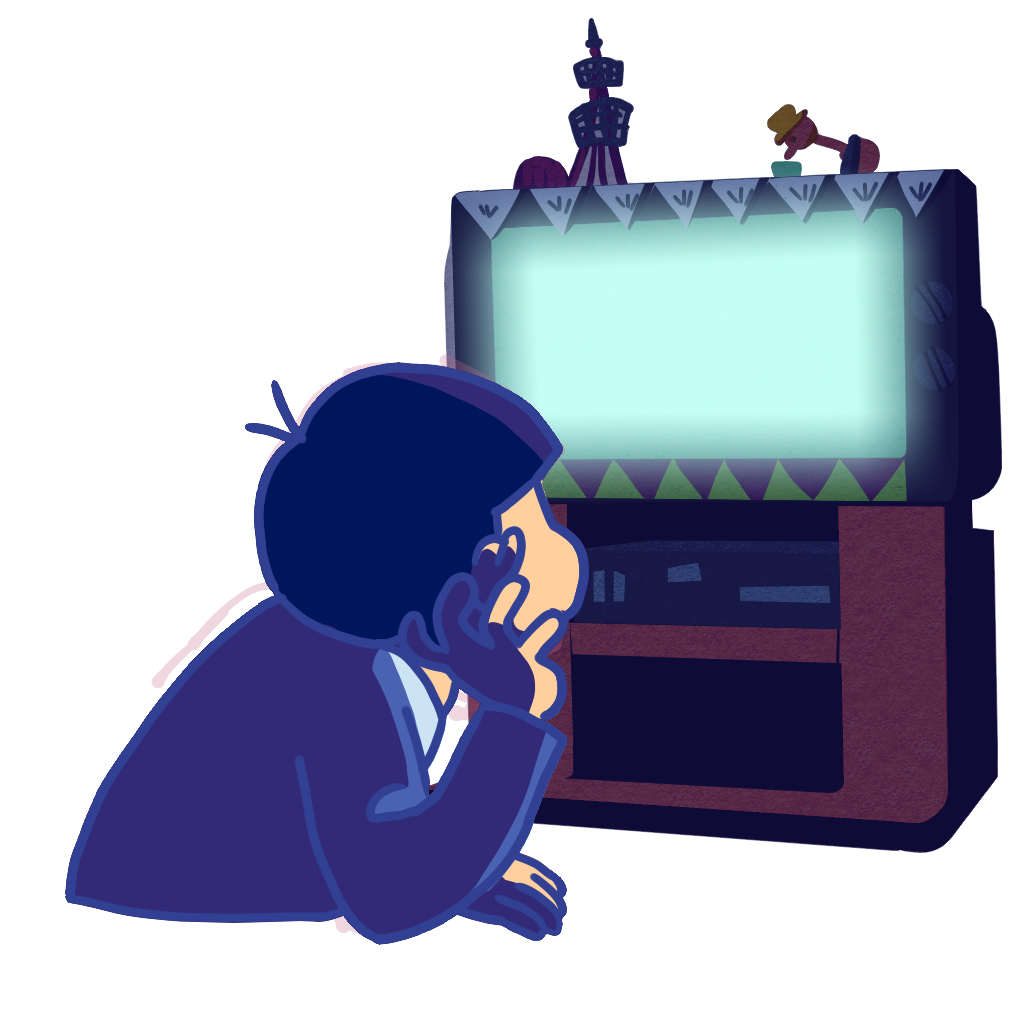
Near the end, the popular episode series was revived one last time, using designs lifted directly from the Osomatsu-sananime : 'Kerosene/Dayon tribe', 'Valentines Day', and 'Totoderella'. The last two were released on valentine's day and mother's day respectively.
The release of these series was unusually unceremonious. While each series contained more than the usual six characters, they were only promoted with a single release graphic.
The artwork for these series also appear to have been referenced directly from anime production material as they use unusual atmospheric lighting.

At the onset of 2022, updates finally began to slow down. One design set per week became one design set every other week, new events were just Oshibari stages and points rallies, and no new stories were released.
Version 5.6.3, released 29 July 2022, was the last update to the game.
For the last two months of service, Hesowars reprinted each of its story events - 89 in all - in chronological order so players could enjoy it to the end. The splash screen also updated to commemorate the anniversaries of major stories like Denki Mystery and Magical NEET Osomatsu.
Perhaps ironically, the sunset era overlapped with a month-long collaboration with karaoke chain KarateZ.

The very last day of service was absolutely bonkers, although it probably wasn't planned to be. Hesokuri Wars went out with one final story event, appropriately named へそくりウォーズ ULTIMATE, which had absolutely everything.
The event was probably supposed to become available on September 23rd, but its maintenance period kept being re-scheduled. Finally, on the 30th of September, maintenance started... and hour by hour, was extended. The event was finally available by the morning (JST) of 01 October 2022, less than a day and a half before the game was to go out of service.
I am just a fan of Osomatsu-san who played Hesowars every day that it was in service. Please do not look directly at me.
I am still hard at work on this page! Here is the to-do list for the next update:
last updated: ニート2023
next update: 03 march 2023!